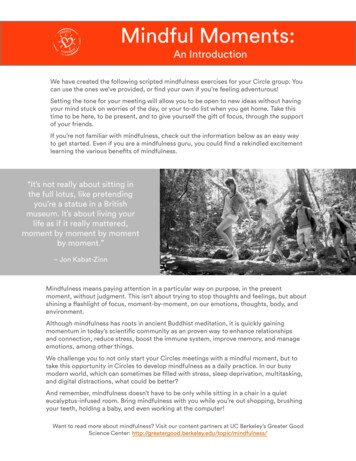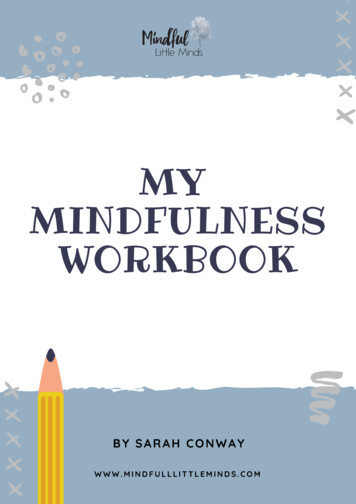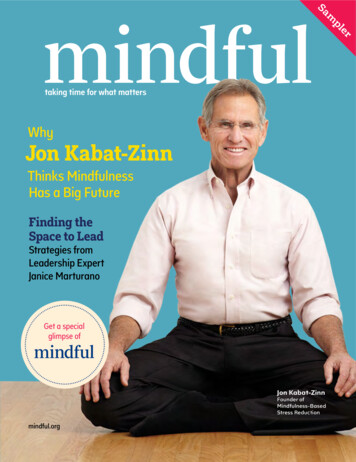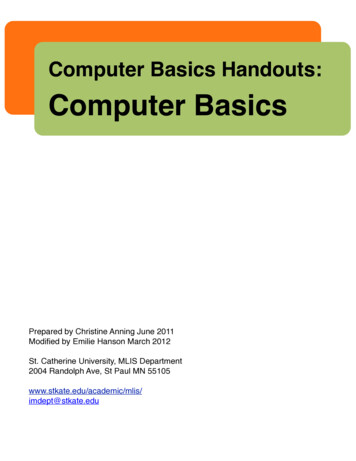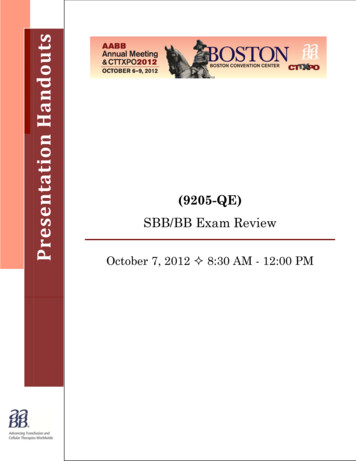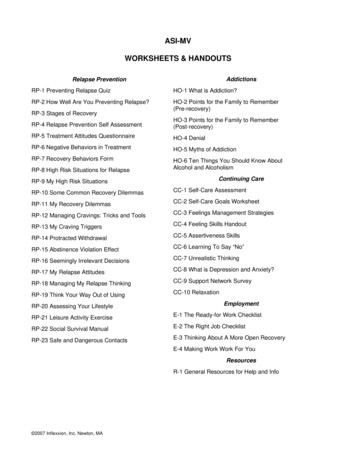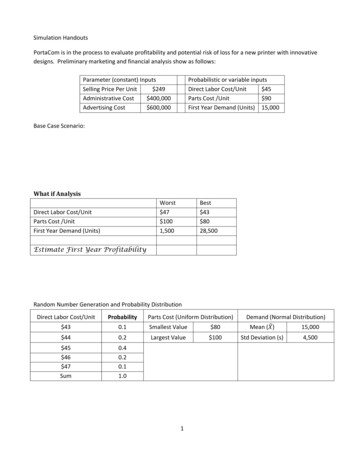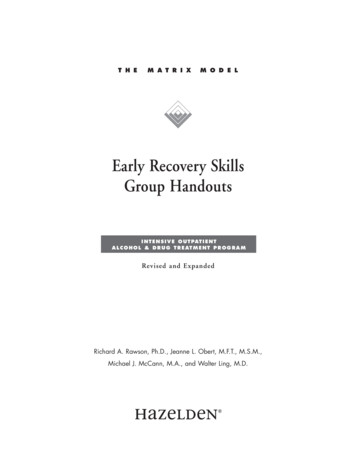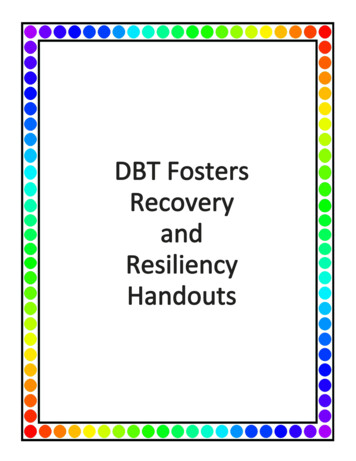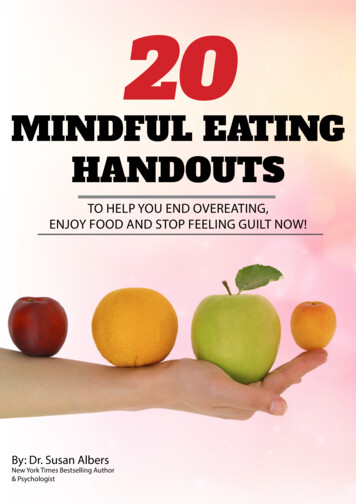
Transcription
20MINDFUL EATINGHANDOUTSTO HELP YOU END OVEREATING,ENJOY FOOD AND STOP FEELING GUILT NOW!By: Dr. Susan AlbersNew York Times Bestselling Author& Psychologist
Published by: www.eatingmindfully.comCopyright Susan Albers PsyD. All rights reserved.DISCLAIMER:The information and ideas in this book are based upon research available at the time of writing as well as inconsultations with licensed medical professionals. This book is intended to be a reference and not a substitute forconsulting with an appropriate health care provider. Any changes or additions to your medical care should be discussedwith your physician. The author and publisher disclaim any liability arisingdirectly or indirectly from this book.www.eatingmindfully.com @Susan Albers 2015
Hello,I’m Dr. Susan Albers, psychologist and authorof the New York Times Bestselling book, EatQ,and six other books on mindful eating. Perhapsyou have purchased this resource because youare a licensed dietitian, therapist, health coach,wellness professional or yoga teacher whohelps people to eat healthier, have more energyand improve their relationship to food. If so, Ihave good news. In this packet, I’ve included 20Essential Mindful Eating Handouts! I’m sharingthe handouts I use most often in my office. Ihope these are as helpful to your clients asthey are mine and that these handouts are anexcellent addition to your education library.Please join my email list at:www.eatingmindfully.comDownload additional free handouts on:www.eatingmindfully.com/motivational.Mindfully yours,Susan Albers PsyDwww.eatingmindfully.com @Susan Albers 2015
HANDOUTCOLLECTIONMindful EatingEmotional EatingBONUS: Mindful Eating Habit TrackerBONUS: Mindful Eating BingoMore Resources List1.2.3.4.5.6.7.8.9.10.Benefits of Mindful Eating5 S’s of Mindful EatingMindful Eating ExerciseHunger ScalePace Not Race: 6 Ways to Eat SlowerThe Mindful Eating PlateMindful Eating QuizDieting vs. Mindful EatingPause ApproachAcceptance of Cravingswww.eatingmindfully.com @Susan Albers 20151.2.3.4.5.6.7.8.9.10.Emotional Hunger vs. Physical Hunger5-5-5-5-5 ExerciseFlow Chart: Emotional Vs. Physical Hunger5 Ways to Respond to Food PushersHelpers Vs. HindersSWAP Approach70 Ways to Soothe Yourself Without Food5, 4, 3, 2, 1, Exercise10 Foods to Help Buffer Stress5 Strategies for Letting Go
BENEFITS OFMINDFUL EATING Not a fad dietRealistic & Do-ableIt lasts! You can do it long termA behavioral plan for everyone (you can be vegetarian, Kosher, a meat eater etc.)!You don’t feel deprived or starvedIt’s works! Research shows that mindful eating is helpful in reducing emotionaleating, weight, Diabetes II, and developing a healthier relationship to food.VSWhat is Mindless Eating?»» Eating when you are bored, stressed, anxious,happy etc. and not truly physically hungry»» Munching in front of the T.V.»» Eating while you are doing something else ordistracted (driving, walking, working, texting).»» Eating food just because it is there and looksgood not because you are hungry»» Falling back into old habits/routines»» Zoned out or eating in a trance like state»» Following rules not body cuesDESCRIBE AN EXAMPLE OFYOUR OWN MINDFUL ANDMINDLESS EATINGwww.eatingmindfully.com @Susan Albers 2015What is Mindful Eating?»» Mindful Eating is not a diet»» There are NO menus or recipes. It is aboutbalancing how to eat, not what to eat.»» Being aware and present when you eat»» Noticing each bite»» Using your senses (taste-spicy, bland), (texturesmooth, crunchy), (aroma, sound-sizzle or crunch)»» Noticing your habits»» Determining your hunger level (a little or alot?)»» Being truly in the moment»» Savoring/Enjoying food»» Feeling in charge of how much you are eating,consciously deciding»» No guilt or judgement
5 S’s of Mindful EatingBy Dr. Susan Albers1) SIT DOWN. Have a seat! Avoid nibbling in front of the refrigerator orsnacking in your car. Put food on a plate. You will enjoy food more and eatless when you give eating your full attention. “Only eat off your feet.”2) SLOWLY CHEW. Eat with your non-dominant hand (if you are right handed eat with your left). Research indicates that eating with your opposite handcan reduce how much you eat by 30%. Intentionally chew slower than theperson you are eating with. “Pace, don’t race.”3) SAVOR. Take a mindful bite. Smell. Taste. Notice and look at each spoonful. Turn off the TV and other distractions. “When you eat, just eat.”4) SIMPLIFY. Put healthy foods in a convenient place like on the counter.Place treats out of view. Research indicates that people tend to eat what is intheir immediately reach. “In sight, in mind, out of sight, out of mind.”5) SMILE. Smiling can create a brief pause between your current bite andthe next one. During that gap, ask yourself if you are just satisfied, not full.“Take a breath, to manage stress.”www.eatingmindfully.com @Susan Albers 2015
MINDFUL EATINGEXERCISE1. MINDFULLY PICK.Choose a piece of food (nuts, fruit, a pieceof chocolate, orange slice).2. LOOK CLOSELY.Describe it to yourself. Color? Shape?3. SMELL.Notice how the smell impacts you. Does itremind you of anything? What memoriesor thoughts does it trigger?4. TRULY TASTE.Do you like it? Texture? Spices? Flavor?5. NOTICE THOUGHTSAND FEELINGSPay attention to whatever emotions andthoughts come to mind. Happy? Sad?Craving more?6. SLOWLY CHEW.Notice how the texture changes.7. FOLLOWThe sensation down your throat asyou swallow.8. PRATICETaking a mindful bite.www.eatingmindfully.com @Susan Albers 2015
MINDFULNESSOF HUNGER SCALE10 Overly full. Uncomfortable feeling in thestomach. Bloated. Feeling regret.9 Very full. You can tell you’ve eaten a largeamount. Emotional and/or physical discomfort.8 Comfortably full.7 Slightly full and satisfied.6 Satiated. Quenched. Appeased stomach.5 Not hungry or full.4 A little hungry. Need a snack. Hunger pangs begin.3 Hungry. Ready for a light meal.2 Ravenously hungry. In need of a complete meal.1 Famished. Extremely hungry. Growlingstomach, low energy, headache.Awareness Level10 Hyper aware thinking about each calorie.Worried about each bite.98765 Aware and in-the-moment. Savoring.4321 Zoned out, trance like eating. Not tasting each bite.Rate your hunger throughout the day. Choose a time to check in and evaluateyour hunger level (on the hour) or a cue (when your mobile phone rings).www.eatingmindfully.com @Susan Albers 2015
PACE NOT RACE6 EASY WAYS TO EAT SLOWER1) If you want to slow down, eat with your nondominant hand (if you are right-handed, eat withyour left). Research indicates that you eat 30% lesswhen you eat with your non-dominant hand. Itinterrupts the automatic hand to mouth flow.2) Say to yourself at least two adjectives to describethe food you are about to eat. For example, say“cold” and “creamy” before you take a bite ofyogurt. This action can insert just the right aboutof time you need to pause.3) Sit Down. It sounds simple enough. However,people tend to eat more rapidly when standing.Think about snacking while standing over the sinkor nibbling from a plate while standing at a party.4) Stagger your bites with another activity. Forexample, one bite and then one comment to yourdining partner. Or, one bite, one sip of water.5) Just observe. Notice how quickly or slowlyother people eat. Use their pace to help you setyour own. Intentionally eat slower or in tandemwith another person’s bites.6) Consider your fork or spoon to be like a tool youneed to reload. Carefully, and intentionally fill yourfork slowly and deliberately.THE PACE MAKERUSE THIS METER TO CHECK IN AND INTENTIONALLY SET YOUR EATING .com @Susan Albers 2015WHOAGO-GOPRONTO
THE MINDFULEATING PLATEwww.eatingmindfully.com @Susan Albers 2015
10 MINDFULEATINGQUESTIONSASK YOURSELF, “DO I TEND TO?”1) Stop eating when I am satisfied.2) Eat when I am hungry rather than emotional.3) Not “pick” and graze on food.4) Taste each bite before reaching for the next.5) Think about how nourishing food is for my body.6) Be nonjudgmental of myself when I accidentally overeat.7) Not multitask when I eat. When I eat just eat.8) Be able to leave some food on my plate if I don’t want it.9) Eat slow, chewing each bite.10) Recognize when I slip into mindless eating (zoned out, popping food into my mouth)BE PRESENTWHEN YOU EATARE YOU ZONED OUT, MINDLESSLY MUNCHING ORPRESENT WHEN YOU EAT?To shift into the moment and be more in-the-moment: Stretch Before You Sit Down Take A Drink of Water or Tea. Hydration Helps to Kick Starts Your Senses Chew a Mint Take A Few Deep Breaths—Send Oxygen to Your Brain Pinch Your Hands a Few Times Name 3 Things You See In Front of You Gratitude. Say a few words of thanks or a prayer before you eat Place food on a pretty placemat or nice dishesMOTTO: Stay Awake At the Plate!www.eatingmindfully.com @Susan Albers 2015
Mindful Eating QuizTHIS IS A BRIEF ASSESSMENT OF YOUR MINDFUL EATING SKILLS (IT ISN’T A DIAGNOSTICASSESSMENT). IT IS TO HELP YOU TO IDENTIFY WHICH SKILLS YOU MAY WANT TO BOOST. DON’TFORGET TO NOTICE WHAT YOU ALREADY DO WELL. AFTER YOU COMPLETE THIS QUIZ, WRITEDOWN A MINDFUL EATING GOAL.1. I tend to stop eating when I am fullAll of the timeMost of the timeOccasionallySometimesAlmost NeverOccasionallySometimesAlmost NeverOccasionallySometimesAlmost NeverSometimesAlmost NeverSometimesAlmost Never2. I eat when I am hungry rather than emotionalAll of the timeMost of the time3. I try not to “pick” or graze on foodAll of the timeMost of the time4. I taste each bite before reaching for the nextAll of the timeMost of the timeOccasionally5. When I eat, I think about how nourishing the food is for my bodyAll of the timeMost of the timeOccasionally6. I am nonjudgmental of myself, my body and when I accidentally overeatAll of the timeMost of the timeOccasionallySometimesAlmost NeverSometimesAlmost Never7. I don’t multitask while I eat. When I eat, I just eatAll of the timeMost of the timeOccasionally8. I don’t have to eat everything on my plate, I can leave what I don’t wantAll of the timeMost of the timeOccasionallySometimesAlmost NeverOccasionallySometimesAlmost Never9. I tend to eat slowly, chewing each biteAll of the timeMost of the time10. I recognize when I slip into mindless eating (zoned out, popping food into my mouth)All of the timeMost of the timeOccasionallySometimesLIST YOUR MINDFUL EATING GOALS:(ex: learn to be more present when I eat, slow down, stop when I’m full)www.eatingmindfully.com @Susan Albers 2015Almost Never
DIETING VS.MINDFUL EATINGDietingWillpowerRulesCultural ConformityWeight LossAvoidanceRigidCounting CaloriesDeprivationDenialQuick FixGuiltShort TermFight FoodMindful EatingConsciousnessListen to Internal SignalsEmpowermentHealth vs. WeightAcceptanceFlexibleNutritionPermissionLong Term ApproachCompassionLifestyleCelebrate andSavor Food1) What diets have you tried in the past?2) What was helpful about the diet?3) What aspects of the diet were difficult?4) What is your most difficult food struggle?5) Which foods are easy and difficult to eat mindfully?www.eatingmindfully.com @Susan Albers 2015
PAUSE MINDFULLYREMEMBER TO PAUSE MINDFULLY WHEN YOU EAT.INTENTIONALLY CREATE A “GAP” BETWEEN EACH .STOP MULTITASKING. WHENYOU EAT, JUST EAT.ASK YOURSELF, HOWPHYSICALLY HUNGRY AM I?HOW ARE MY FEELINGS IMPACTINGMY FOOD CHOICE?TAKE A MINDFUL BITE. SMELL,TASTE, TOUCH, LISTEN!ARE YOU REALLYENJOYING THIS BITE?www.eatingmindfully.com @Susan Albers 2015
ACCEPTANCEOF CRAVINGSACCEPTANCEWhen you have a cravings, your firstinclination may be to tell it to, “JUSTGO AWAY.” Turning off a craving is notso easy. “Acceptance based strategies”advise you to do the opposite—welcomein the craving. Mindfully talking yourselfthrough it gives you much more powerover how much you eat.ACKNOWLEDGE:Say to yourself, “I’m having a craving!” Ithas arrived—whether you like it or not.ACCEPT:Tell yourself, “It’s okay.” Don’t try to talkyourself out of the craving, judge orrationalize it. If your mind goes thereanyway, just take note of it. Remember:the craving is just a feeling not a fact andnothing more. Just because you have athought doesn’t mean you have to do it.ALERT:Tune into what you are feeling. Is it hardto wait? Where does it bother you themost in your body?AWAIT:Your mind might say, “You have to givein or the craving will never go away.”Remind yourself, this is just a thought.Tell yourself, “I can take it.” The cravingwill change in form and nature. Whenyou don’t respond to the first urge to eat,the craving often lessens and sometimeseven passes completely. Ride out thecraving like you are on a wave in theocean, not sinking into it, just skimmingon top of it.AWARENESS:Be aware of your options. MindfullyCHOOSE rather than acting on autopilot.Eat it mindfully-slowly and with intention.This approach may seem radical and goes against the grain of most diets. Try it! Researchin the journal of Appetite has found it to be effective in coping effectively with cravings.www.eatingmindfully.com @Susan Albers 2015
MINDFUL & MINDLESSEATING HABIT TRACKERSome mindless eating is just a habit—something you do out of routine ratherthan triggered by emotion. For example eating the same foods, munching atyour desk, eating at the same time each day. Take notes and gather data onyour habits for one UNDAYwww.eatingmindfully.com @Susan Albers 2015
www.eatingmindfully.com @Susan Albers 2015
EMOTIONALEATINGVSPHYSICALEMOTIONALStomach growlingNo physical cues (quiet stomach)Thinking, about food, considering optionsSpecific cravingsLow energyEating feels like the best/only optionHunger slowly growsLittle time has passed since last biteTime passes since last meal/snackFood doesn’t feel satisfyingFood is satisfyingYOUR PHYSICALCUES OF HUNGEREMOTIONAL CUESOF HUNGERWhat triggered your hunger?(Situations? Feelings?)What triggered your hunger?(Situations? Feelings?)Where were you when the craving began?(Are there places that prompt you to eat?)Where were you when the craving began?(Are there places that prompt you to eat?)When did it start?(When was the last time you ate? When did thecraving start?)When did it start?(When was the last time you ate? When did thecraving start?)Why are you desiring to eat?Why are you desiring to eat?www.eatingmindfully.com @Susan Albers 2015
5-5-5-5-5EXERCISEFeeling the urge to comfort eat? Avoid emotional eating by having a solid plan in place.Write down a list of 5 strategies for each category. Hang this sheet in hot spots foremotional eating like on your desk or refrigerator.5 Activities that RELAX you (ex. Flip through a magazine, a 5 minute break, lay on the couch).1)2)3)4)5)5 Activities that DISTRACT you (ex. email, games, cleaning).1)2)3)4)5)5 Activities PLACES you can go that are comforting to you (ex. Your bed, garden, cozy chair).1)2)3)4)5)5 PEOPLE to call and connect with you (ex. your best friend, mother, sister, mentor).1)2)3)4)5)5 THINGS that soothe your senses (cool cloth on head, comfortable clothing, turn down lights)1)2)3)4)5)Choose one of these activities to do for5 Minutes or until the urge to Eat emotionally passes.www.eatingmindfully.com @Susan Albers 2015
Emotional Vs.Physical Hunger4 Ways to Tell the Difference1) SATISFACTION VS. RELIEFDo I want to eat for energy to fuel my bodyto make it through the day or am I lookingfor relief or a sense of safety/security?TEST: Place your hand on the part of yourbody that needs attention. Does it go to yourstomach because it is rumbling? Or, does itgo to your brain that feels dull and bored?Fix: Aim to satisfy the part of the body thatyour hand rests on. If your brain is bored,give it some mentally stimulating material.If your hand traveled to your shoulders, liftand release your shoulders five times to relax your muscles. If it lands on your stomach,mindfully choose a nourishing food.2) EMOTIONAL VS. PHYSICAL HUNGERAm I eating in response to physical hunger(rumbling stomach, low energy, etc) versusfeeling scared, frustrated, overwhelmed orhappy.Test: Ask yourself, “How physically hungryam I on a scale from 1-10 (1 starving, 5 satiated 10 overly full)?” If you are a 1-5, it’slikely that you do need something to eat. Ifso, that is okay. If you answer 6-10, it’s likelythat food isn’t going to help a bit.Fix: Try eating a Mandarin orange. They are agreat food to help curb emotional eating andto de-stress. It is easy to peel and the segmentsare perfectly portioned to mindfully eat one ata time. The sweet flavor is satisfying and citrusaromas have been shown to be calming, according to research. Also, a Mandarin orangegives a little boost of vitamin C, just what youneed when stressed or emotional.www.eatingmindfully.com @Susan Albers 20153) NUTRITIOUS VS. PALATABLEAm I choosing nutrient rich foods vs. sugary,fatty salty foods?Test: A truly hungry person, will eat a largerange of foods that will quickly quiet arumbling stomach. Someone with an emotionally driven craving often only cravesa specific type of food or taste—not justchocolate, but chocolate with caramel. Ifonly a salty snack will do, it’s likely that thisis an urge for comfort.FIX: It’s important to keep on hand healthysnacks that do taste good to you. Often,people keep diet foods around that arebland and don’t taste good. Kick up the tasteof vegetables with hummus, sprinkle yogurtwith some nuts, drizzle chocolate on berries,dash in spices to vegetable soup etc.4) LIFELONG VS. TRANSIENTAm I building a healthy relationship withfood vs. anxiety, guilt or fear.Test: Before you eat, ask yourself how youwill likely feel a minute after you finish thisbite. If a negative emotion springs to mind,take a pause. Too often we wait until afterwe eat to check in with the emotional impact of what we consume.FIX: Mindful eating can help you build ahealthy and balanced relationship with food.Use the 5 S’s of Mindful Eating no matter whatyou are eating 1) Sit down 2) Slowly Chew3) Sense—taste, smell, listen 4) Savor-enjoy5) Smile (pause before taking another bite).Remember it’s okay to eat the foods youlove, as long as you do it mindfully!
Emotional Vs.Physical HungerAM I HUNGRY?PHYSICALStomach growlingThinking/considering optionsLow energyHunger grows slowlyTime has passed since last mealFood is satisfyingYESEatHealthyVS.UnhealthyEat it Mindfullywww.eatingmindfully.com @Susan Albers 2015EMOTIONALWhat emotions triggered the situation? (anger,boredom, stress)How strong were the emotions? (mild? intense?)When did the feeling start?What did you hope food would do?(soothe/escape feelings, make you feel better?)NODistractionORGet out of KitchenKeep Hands BusyConnectCleanReadExercise/MoveMindless activityComfortRelaxBreathe DeeplySleep/Lay DownUnplug from ElectronicsConnect/Be SocialSoothe Body
5 WAYS TO RESPONDTO FOOD PUSHERSPicture this. You are at a party. A friend pushes a piece of pie into yourhands and says, “Have another piece, it’s a party after all. You can afford toeat more.” How do you respond?1) HUMOR: Say, “No, thank you! I couldn’teat another piece! I’m starting to feel like aturkey-just a little too stuffed! Keep it lighthearted.to make it come out effortlessly. Other peopleeasily push past a wishy-washy no.2) TEACHING MOMENTS: Hold up your handand make a fist. Say, “Did you know this is theactual size of your stomach?’ It’s amazing tothink about how much we try to put in there!”4) REASSURANCE: Remember that thecomments people make are often a reflectionof their own fears and insecurities. Offeringreassurance may help to take the pressure andfocus off of you. Say, “It sounds like you wouldlike another piece. Go for it!”3) NO THANK YOU!: It’s okay to say no. It’sas simple as that. Too often, we are afraid toput down limits. Say “no” politely but withconviction. Practice when you are by yourself5) DIVERT AND DEFLECT: Be sure to handout a compliment, “The pie is fantastic! Do youhave the recipe?” This can redirect the focusfrom eating to learning how to make it.www.eatingmindfully.com @Susan Albers 2015
HELPERS VS.HINDERERCHARACTERISTICSOF HELPERSCHARACTERISTICSOF HINDERERSWHO ARE YOUR HELPERS?WHO ARE YOUR HINDERS?»» Encouraging words»» Supportive social media posts»» Cuts out articles/give you helpful information»» Cheerleading & good listening»» Positive role modeling of eating/choosinghealthy foods»» Reassuring»» No pressure»» Helps you shops for healthy food»» Provides healthy food»» Sits down at a table to eat with you»» Encourages you to take charge»» Uses non-food rewards»» Healthy ways to de-stresswww.eatingmindfully.com @Susan Albers 2015»» Competitive»» Critical»» Brings you unhealthy foods»» Pressures you to eat»» Makes fun of your efforts»» Mixed messages or unhelpful comments»» Stocks home with unhealthy foods»» Tries to control your eating»» Negative comments about your body»» Rewards with food»» Suggests comforting yourself with food»» Name calling (ex. lazy)
S.W.A.P.TECHNIQUESWAP MOMENT: Instead of emotional eating, try the S.W.A.P. approach.Swap out emotional eating and insert something else (an activity, breathingexercise, movement) else in its place.SAY: Say clearly how you feel. Angry? Hurt? Bored?Stressed? Be mindful of your feelings. If you are genuinely hungry, eat. If not, move on to the next step.to try to remove food or wrestle with your hunger.Instead, think about the feeling and what will helpsoothe and calm yourself without calories.WAIT: Don’t act immediately. Imagine creating agap between the thought “I want to eat” and theresponse or action of doing it. Count to 5 if you haveto or say, “Pause.” Use imagery to freeze in place as ifplaying a game of Simon Says.ADDRESS THE FEELING NOT THE FOOD: Target thefeeling instead of the desire to eat. It’s temptingPURSUE ANOTHER ACTIVITY: If you take out comforteating, you have to put something else in its place.Choose 1 activity to do from 50 Ways to SootheYourself Without Food to help you to replace emotional eating with a healthier behavior. Try it for justfive minutes. If you are truly engaged in the urgeto emotionally eat, inserting something else in itsplace can help you to break free.BODY(Hot bath, comfortable clothing, exercise)MIND(Hot bath, comfortable clothing, exercise)SENSES(Cool cloth on your forehead, feet up)CONNECT(Vent to a friend, email, social media)www.eatingmindfully.com @Susan Albers 2015
10 FOODS TO HELPBUFFER STRESSSome foods buffer your body against the effects of stress while others contribute to it.Here is a list of 10 foods that may help prevent emotional eating and soothe your mood.1) Dark Chocolate: Contains flavonoids andhelps release mood boosting chemicals such asdopamine.2) Oatmeal: The fiber will keep you feeling full for along period of time and helps regulate your bloodsugar. Complex carbs are involved in the release ofserotonin which produces a sense of calmness.3) Oranges are high in vitamin C which boosts theimmune system and reduces cortisol levels.4) Spinach is high in magnesium—this plays akey role in regulating and lowering blood pressurenaturally (blood pressure is often raised by stress!)5) Skim Milk helps to reduce stress-related PMSsymptoms and also produces a calming sensation.6) Salmon contains Omega-3 which helps reduceinflammation and pain.7) Black Tea naturally reduces cortisol levels, thestress hormone that makes you crave sugary, fattyfoods.8) Avocados contain healthy fats which keeps youmore satisfied and helps regulate nerve communication, which makes you think clearer.9) Almonds have Vitamin E to boost the immunesystem and well as B Vitamins. Both nutrientscan make you more resilient to stress.10) Pistachios are the lowest fat and calorie nut.They help to keep your blood sugar regulated andyour mood stable.FOODS THAT BOOST MY MOOD:FOODS THAT DEFLATE MY MOOD:TODAY’S MOTTO: “EAT FOODS THAT ENHANCE YOUR MOOD.”www.eatingmindfully.com @Susan Albers 2015
70 WAYS TO CALM & COMFORT YOURSELFFocus meditationWalk your dog/pet your catWrap in a blanketJumping jacks in place 10XCreate a tent to snuggle underDoorway stretchesTurn down lights, turn down noiseMove mindfully, listen to your feet hit the floorSoothing music slows your heartbeatPower Poses, like Wonder WomanDeep breathingDance like you are on stageChoose and repeat a mantraCall a friend, ask a specific question5 minute Time OutWalk your dog in the park, talk to other pet ownersPut on comfy pants and sweatshirtPursue social media or PinterestWrite a HaikuList 15 things you like about a friend, share itSqueeze bubble wrapEmail or text someoneBlow bubbles and meditateVent to someone who will listenPower journal, write about your best and worst momentsIntentionally smileGoogle an intriguing topicDelegate a taskRead or study something newMake play doh or wiggly jelloTalk out loud to an empty chairKnit, get your hands movingVisualize what you wantScrapbook, picturesDaydream about a vacationMake jewelryMake a calendar or list, organizeDecorate a room, or rearrangeMemorize a poemCreate a vision board or comic bookMake a timeline of important life eventsCreate reminders, post-it notesSoak in the tub with Epsom saltScribble, doodle, ZentangleEssential oils, rub lotionsDraw with sidewalk chalkGreen therapy, go outside or for a hikeRepurpose old clothingChange sensations, drink hot or cold waterTurn on the TV, host a movie or Netflix marathonTake a power or cat napFlip through a magazine, tear out soothing picturesWind down ritualMake a gingerbread house or food sculptureDrink black tea or fruit herbal teaClean one drawer, organize your booksSelf massageOrigamiMake a bucket listChange scenery, move to a different room/spaceRub worry beadsPlay a game on your phoneRun up and down the stairs 5XDo your own pedicure or manicureWash your carMake a gratitude list as long as you canWalk for 20 minutesLearn one new word5 yoga posesChew on a toothpickwww.eatingmindfully.com @Susan Albers 2015
SOOTHINGYOURSENSESCOUNTING ONYOUR SENSES5-4-3-2-1Clear your thoughts of food byfocuses on your senses.1. State one scent you cansmell. (Touch your pointerfinger to your thumb).2. Name two sounds you canhear. (Touch your middlefinger to your thumb).3. Describe 3 sensations yourbody is feeling, such as temperature, the texture of yoursweater, your feet againstthe ground. (Touch yourringer finger to your thumb).4. Identify four colors you see.(Touch your pinky to yourthumb).5. To yourself, name fivethings you see in front ofyou. (Make a fist, then openyour hand, stretch your fingers out in a fan, and closeyour hand again, repeat).www.eatingmindfully.com @Susan Albers 2015
5 STRATEGIESFOR LETTING GOINSTEAD OF STEWING, DWELLING OR RANTING, LET YOUR THOUGHTGO AND COOL DOWN HOT FEELINGS WITH THESE TECHNIQUES!1) TEACHING MOMENTS: Think about what wisdom this experience teaches you.2) BIG PICTURE: Ask yourself, will this situationreally matter in 5 minutes, 5 months, 5 years?3) NAME THE FEELING: Naming your feelingscan help to manage them. For example, think of aword that represents a strong emotion or cravingthat you have and write that down on a piece ofpaper so that the word is vertical on the center of apage. For example if I chose the emotion anxiety, Iwould write it like this:ANX I E T YNow you are going to create a poem by usingeach letter to start a word, A—Am angry at mymother. N—Nothing I eat will make it better, etc.You can also start a sentence to the left endingwith a word that begins with the letter listed onthat particular line. A--I think I’m craving an Apple. This can be a lot of fun!www.eatingmindfully.com @Susan Albers 20151) IMAGERY: Imagine that you are sitting in a carin front of train tracks. On each car is one of yourthoughts. You are watching the thoughts travel infront of you and continue on into the distance.2) DETACH: Imagine watching your thoughtswritten in smoke rising from a fire. The thoughtsdisappear into a puff.3) DISTORTION: Identify whether there are anycommon thinking distortions. Black & White thinking. Catastrophizing or jumping to conclusions.4) ACCEPTANCE: You don’t have to like thesituation but work on accepting it. Remindyourself, “It is what it is.”5) MANTRA: Find a calming mantra like “this toowill pass” or “progress, not perfection.” Prayers,quotes, motivational sayings can help.6) SLEEP ON IT: Don’t react to your thoughts, respond to them. Sleep on it. Allow yourself somedistance from the situation before acting on yourfeelings. This can cool down hot feelings.
www.eatingmindfully.com @Susan Albers 2015
BOOKS BYDR. ALBERS:EATING MINDFULLYA handbook with the basics of mindful eating.Tips & techniques.EAT, DRINK & BE MINDFULA workbook on learning mindful eating skills.EATQEmotional intelligence skills blended withmindfulness. Scientifically based new skills.BUT I DESERVE THISCHOCOLATE50 strategies for getting past excuses,rationalizations and self-sabotage and boostingyour motivation.50 WAYS TO SOOTHEYOURSELF WITHOUT FOOD50 strategies for replacing emotional eating withhealthy activities.50 MORE WAYS TO SOOTHEYOURSELF FOODThe sequel to Dr. Albers’ book 50 Ways to SootheYourself Without Food.MINDFUL EATING 101A handbook for college studentsto learn mindful eating.www.eatingmindfully.com @Susan Albers 2015
PROGRAMSMindful Eating Pledge. Poster to hang onyour refrigerator or desk. (Download for free atwww.eatingmindfully.com)Mindful Eating Toolkit (mindful eating audiorecordings) www.eatingmindfully.comMindful Eating Toolkit for Professionalswww.eatingmindfully.comABOUTDR. ALBERSSusan Albers, Psy.D., is a clinical psychologistat the Cleveland Clinic. She specializes infood psychology, weight loss, a healthy bodyimage, and mindfulness. After obtaininga masters and doctorate degree from theUniversity of Denver, Dr. Albers completedan APA internship at the University of NotreDame in South Bend, Indiana and a postdoctoral fellowship at Stanford Universityin Califo
Jan 20, 2016 · of the New York Times Bestselling book, EatQ, and six other books on mindful eating. Perhaps you have purchased this resource because you are a licensed dietitian, therapist, health coach, wellness professional or yoga teacher who helps people to eat healthier, have more energy and imp

